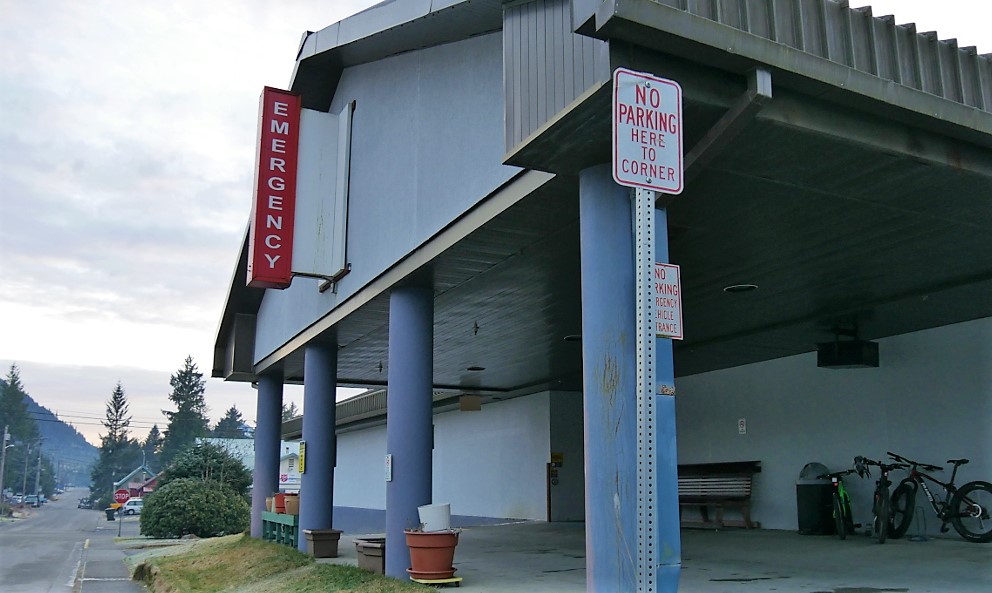
For many hospitals, the COVID-19 pandemic has exposed the fragility of healthcare infrastructure. At Petersburg Medical Center, failing systems in the aging community hospital have been a concern for years.
The pandemic hit just as PMC received the borough assembly’s support to pursue a phased approach to building a new facility. In the first of a three-part series about the future of healthcare in Petersburg, Katie Anastas toured the hospital and talked to staff about new challenges they’re seeing now.
Outside the Petersburg Medical Center, signs are posted on the windows about free COVID vaccinations and testing.
But inside, the pandemic is highlighting challenges that are more hidden: a lack of storage space and limited electrical capacity.
Mike Boggs, the medical center’s maintenance and plant manager, opened a door on the first floor. Desks for the physical therapists are in one corner of the room. The rest of it is storage for all the new supplies they’ve had to order during the pandemic: masks, gowns, emergency oxygen and ventilator equipment.
“It’s like being a fisherman of multiple fisheries without a warehouse,” Boggs said. “So we don’t have a place to put our seine net when it’s crab season or vice versa.”
It’s long been known that the facility is aging — the medical center conducted a facility needs assessment in 2015, and a community needs assessment in 2017. Plumbing issues are frequent. Some parts of the building have been remodeled in recent years, but others haven’t been upgraded since the 1950s or ‘80s. Just getting new beds through the old door frames can be difficult.
“Things just don’t fit through the doors,” Boggs said. “In modern hospitals the doors are three inches, four inches wider.”
The lack of space is especially challenging in the long-term care section of the facility, said chief nursing officer Jennifer Bryner. Those residents often require larger equipment, like lifts to help them get from a bed to a wheelchair.
“We have several double bedrooms,” she said. “If people need a lot of equipment for just their basic tasks, if there are two beds in the room, they’re running into things, it’s hard to get around the second bed. If they don’t have a roommate, we take that bed out, but there’s no place to store the bed except for an empty patient room. We make every empty space into storage.”
Another challenge in long-term care is a lack of outlets. There are four outlets in each room. When Bryner started working at PMC 25 years ago, she said, residents weren’t plugging in things like cell phones or laptops.
“The men came with an electric razor, and that was really the thing to plug in,” she said. “Now, you have still an electric razor, but everybody’s got a cell phone and oftentimes a laptop or computer. So just the basics, from what the resident needs, it takes all the outlets in the room. And then the beds plug in. And we just need more access to the technology that people live with today.”
They’ve added some additional outlets when they can, but that puts an even heavier load on the hospital’s electrical system and backup generator. Especially when the hospital gets new CT scanners, x-ray machines — or this year — ventilators.
“It’s newer stuff, but it draws more juice,” Boggs said.
Phil Hofstetter, PMC’s CEO, said the constant shuffle of equipment and beds can get overwhelming.
“To me, it trickles down to patient care,” he said. “How do we make our facility an environment the best for patient care? Well, if nurses are having to deal with something like moving a steam table out of a room to make room for a resident to come in or a patient to come in, it really disheartens me.”
Storage problems, the lack of outlets, and an electrical system that can’t keep up with new technology are all reasons why, he said, PMC needs to build a new hospital.
“As an administrator, when I hear in the community we don’t need a new facility or it’s too expensive or things like that, it’s really hard,” he said. “The challenges we see on a day to day basis, it’s hard to actually articulate that to the community.”
The medical center’s board has voted to pursue construction of a new building. This year, the borough assembly backed a phased approach to that project.
But how to pay for the new facility — and who should run it — are points of contention for many in Petersburg.
PMC isn’t the only one vying for resident support. The Southeast Alaska Regional Health Consortium, or SEARHC, is an Alaska Native-run nonprofit that also wants to build and operate a new hospital in Petersburg.
In the next story in this series, we hear about the yard signs in Petersburg supporting SEARHC.










